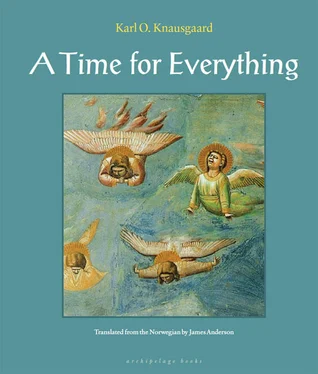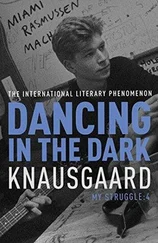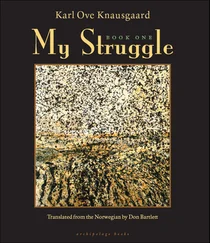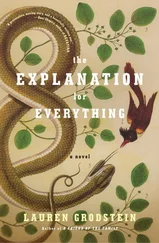The new worldview, which began to take shape in the sixteenth and seventeenth centuries, didn’t just mold the future, but also the past. The story of the past was divided in two, one part dealt with culture, the other nature. The new worldview had a slightly patronizing attitude to cultural history, as all the people there had always held different views, and consequently had never understood the true nature of the world, whereas the history of natural things was seen as something objective, something that had developed outside the human sphere, and that the human sphere was only now, for the first time, capable of mapping out. A past was constructed from the contemporary view of the world, and so this past always affirmed the contemporary view of the world, in a vicious circle that nothing seemed able to break. It’s become an everlasting round. Mistake confirms mistake confirms mistake. For it isn’t like that, but like this:
The history of natural things is indissolubly linked with the history of mankind. Everything we know is inextricably linked with loss and oblivion. And what knowledge does conquer is so infinitesimally small in comparison with what it jettisons that we might reasonably suspect it of being in retreat: why else does it always set its abandoned landscapes on fire?
Sir Isaac Newton, who described gravity and laid the foundations for mechanistic philosophy in his masterwork Principia Mathematica (1687), spent a considerably larger part of his time on alchemy than on the science his fame rests on, and all through his life remained fascinated by King Solomon’s temple, the proportions of which he believed were not only a paradigm for the universe, but also for mankind, so that by calculating the building’s dimensions, and then putting the figures into the Bible’s prophetic texts, one could see into the future. (Newton calculated, among other things, that the great trials of the Jews would end in 1944, and Christ would return in 1948.) And Sir Thomas Browne, who in Pseudodoxia epidemica (1646) attempted to tidy up all the misunderstandings that unreasonable interpretations of the Bible and the classics of antiquity had occasioned over the years, published Hydriotaphia — Urn-Burial just a dozen years later, where he elicits proof that it was the River Jordan that once ran through the Garden of Eden, and that Noah was the same person as the Roman god Saturn. The book also contains a dissertation on the significance of the number five in the world, in which the occurrence of the quincunx, i.e., the pattern representing the number five on a die, which according to Browne was found everywhere in nature ever since the creation, forms a key part. Galileo Galilei, for his part, tried to unite science and the revelation in a less well-known thesis, Letter to Castelli , in 1614.
It’s common to explain the extraordinary results they arrived at by remarking that at the time equal weight was given to scriptural and traditional authority as to one’s own observations, and that as yet people hadn’t developed any sure way of distinguishing fact from speculation. This only fully arrived with Newton, who characteristically enough never publicized the results of his comprehensive alchemical and numerological studies, but throughout his entire life kept this aspect of his activities concealed from everyone apart from a few like-minded people, and as a result stood on the very boundary between new and old: he knew that Christ would return in 1948, but because he couldn’t prove it, that is, eliminate the speculative and hypothetical part of his reasoning, he chose to keep his insight to himself. The same held for his theory of gravity. He had shown in Principia that gravity affects all bodies, and that it operates at a distance. But he wrote nothing about how it operates. During the final years of his life, Newton worked intensively on this question, but since the explanation he arrived at then, that the ether through which gravity works consists of Christ’s spiritual, immaterial body, wasn’t provable, he didn’t publicize this theory either. The distinction between verifiable and nonverifiable was reinforced by Newton’s descendants, who for more than two centuries concealed the speculative part of his research, presumably out of the conviction that the authority of his scientific theories would be weakened if it became known that they were merely a by-product of his tireless search for corroboration of the divine presence in the universe. Their strategy was successful. During the eighteenth century the verifiable became sovereign within science, and has remained so to this day. But the method developed for distinguishing between true and false is based, as we well know, on replication — in order for an observation or experiment to be valid, it must be repeatable, and the results must be the same each time — which naturally condemns things that happen only once, and the unique and exceptional, to fall outside its parameters. And therefore it’s as if they don’t exist. Wonders, miracles, supernatural events — all are swept away in the name of the verifiable. The first consequence of this new method of seeing the world was that divine manifestations began to be regarded as historical. No one doubted that the miracles described in the Bible really had happened, but as nothing of that kind occurred anymore, as far as one could tell, it was assumed that it was a product of the times, and not the world per se. Sir Thomas Browne mulled over these problems in his Religio Medici (1635):
That miracles are ceased, I can neither prove nor absolutely deny, much less define the time and period of their cessation. That they survived Christ is manifest upon record of Scripture: that they outlived the apostles also, and were revived at the conversion of nations many years after, we cannot deny, if we shall not question those writers whose testimonies we do not controvert in points that make for our own opinions: therefore, that may have some truth in it, that is reported by the Jesuits of their miracles in the Indies. I could wish it were true, or had any other testimony than their own pens.
We can see here what enormous problems the new worldview brought with it. When the divine presence could not be confirmed in the world around them, they set up a kind of reserve for it, originally safely ensconced behind the ramparts of history. They wavered between scripture and the world, but the two things were no longer equal; belief in the first was already subordinate to certainty about the second, and it didn’t take long for the desire for it to be “true” to move into the provisional area that had been reserved for divine manifestations. For if the age were a different one, the space was the same. In other words, the divine was equally seen as absent, as its expressions belonged to a past age, and present, because the results of those expressions were integrated in geographical reality: somewhere was the Garden of Eden, somewhere was Noah’s Ark, somewhere was Christ’s grave. This opened the potential, unique to the seventeenth century, to see the divine in the light of what was known about natural history, and not the other way round. When Olof Rudbeck examined the natural history of Atlantis, for example, he described in detail the effects the great flood must have had on the wildlife of Sweden. Using comparisons with various floods he’d witnessed in the area around Uppsala, he worked out how long it would have needed to recover, and tried to discover how many years it took Noah’s descendants to repopulate the world.
To us it seems odd to see items of faith being drawn inside reason’s sphere in this way, there is something impure and almost abominable in this hodgepodge, and only very few would take the results achieved seriously. At best we view them as inadequacies in a system that still hadn’t run itself in, necessary for development, but worthless in themselves. However, this didn’t last long, maybe only a century, before all traces of the old faith had been completely expunged from the domain of reason. By regarding the manifestations of the divine as historical, they were portrayed as rigid and unchanging, and had about as little chance of defending themselves against the advances of reason as a tree has against the woodsman’s ax. In reality, it was just a matter of time before the situation would become what it’s turned into today, where everything connected with the holy is regarded as abstract, so that we literally do not see the materiality of what is holy, whereas everything that concerns physical nature is exclusively seen as concrete, and we lose sight of physical nature’s immaterial aspects, too.
Читать дальше












